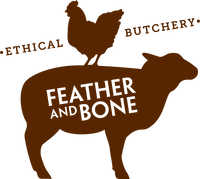
Farm reports: Allyn River Galloways
Covid-19 prevents us going to visit farms at the moment so we've asked them all to do a show and tell video so we can see what's happening on the ground.
Here is the next in our series of farm reports, sent to us by Adrian Honnery and Valentyna Jurkiw. Adrian and Valentyna send us their lovely, shaggy Galloway cattle grown on their hilly property near Barrington Tops, NSW and we wrote about their story - A dream come true.
Adrian sent us this video and also wrote the poignant and informative piece below about their experience at Allyn River over the last few years.
'Our last four summers were long, hot and dry. Rainfall was well below average, and temperatures much higher than average. The river slowed to a trickle and stopped running altogether in three of those summers, while the creek was dry for four long years.
This weather pattern is significant because summer is by far the wettest season for us on average.
Some say that when you see foam on the river it is a portent of rain, just like hearing the cry of black cockatoos as they fly up stream. But when the river is dry, there is no chance of seeing any foam and the black cockatoos have long gone. Limbs of large eucalypts start to crack and fall, which leads to a friendly debate as to whether this is a sign that rain is to come or that the trees too are struggling through the dry.
The rain must come, and it does. Sometimes building slowly, other times taking one by surprise.
Last summer, though, was different.
There had not been much lead-up rainfall. The creek stopped flowing in October, and the river stopped in early November. Dams were already under pressure, and the full blast of summer heat was yet to come. And hanging over everything was the blanket of smoke at the beginning of what was to turn into a devastating bushfire season.
The daily routine becomes obsessive and compulsive. Check the forecast, for maximum temperature and possibility of rain. Check the dams, for water level and any stuck animals. Check the pasture, for quantity and quality of feed. Check the cattle, check the cattle, check the cattle. Check the water tank for the troughs, and check the pump hole in the river as it shrinks through evaporation. Check the cattle again. Every day weighing up how much drinking water to pump for the cows from the river, how many days of water left in the dams if any, how much healthy feed in the paddocks.
Added to the routine was the Mount Royal bushfire up the road, which had been broiling for months until it flared up in late December. The day after the embers from that fire fell on our property, I was with my fellow RFS volunteers on the fireground working to control the fire. For a while it looked likely the fire would tear through the properties of friends and neighbours, and burn irreplaceable portions of the National Park. After a week or so, the fire was contained through hard work and favourable weather. Although there was some damage to property, the irreplaceable portions of the National Park were saved. Without the help of my partner, Valentyna, and her spending every day of her summer vacation looking after the farm it would have been impossibly difficult.
There is no right answer to an existential calculus other than time.
It took 70 days before the river started to run again, and what a relief that was to see our crook old friend return to health. There had been some heavy rain up in the National Park which did not fall on our place, but soon after we received good rain. In the first four months of this year, we have had enough rain to fill our dams and match our total for all of last year.
The pasture has bounced back quickly - along with toxic weeds like lantana, thornapple, cotton bush and fireweed, so there is plenty of pulling, crimping and slashing ahead of us. Many trees, though, were so burnt by the sun that they have budded on their trunks and larger limbs as if burnt by fire, and some others sadly did not recover. Fortunately, though, we made it through and, importantly, without losing any cattle.'
Why Farm Reports?
The necessary Covid isolation regime has successfully reduced the infection curve but it's also increased the sense of distance most of us already have from the sources of our food. So, after the rollercoaster of drought, fires, flood and pandemic over the last six months, we felt it was high time for all of us to re-connect with the farmers whose produce we enjoy each week.
So far, we've received reports from Working With Nature near Guyra, Farmer Brown Eggs near Spicers Creek, Gundooee Organic Wagyu near Leadville, Grassland Poultry near Wellington and Allyn River Galloways near Barrington Tops - all in NSW.
When we visited these farms in August and September last year, after three years of drought, everything was parched and dusty and even the most stalwart characters were clearly very anxious. This year almost everyone has had some rain and it's wonderful to see green pastures and full dams and cheerful, relieved farmers celebrating the reprieve.
Although it's important to remember that not everyone has received rain and the long-term forecasts are for more dry weather.
We'll keep bringing you these reports as they come to hand.

